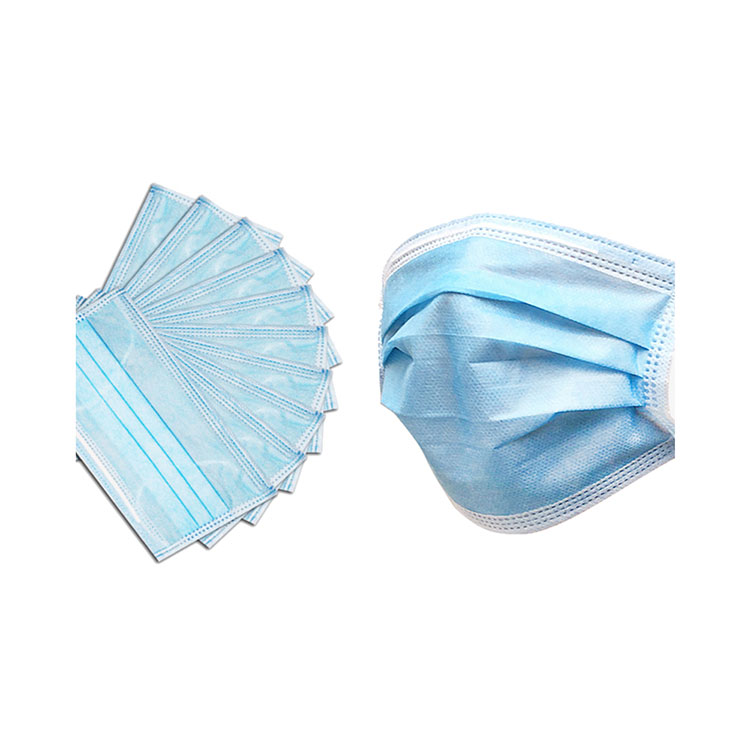
Disposable medical masks are designed to cover the wearer's mouth, nose, and chin. They are used in general medical settings to protect against small amounts of airborne particles, are not potentially infectious, or block contaminants exhaled or sprayed from the mouth and nose. The mask should be neat and in good shape, free of surface damage or stains. When properly donned, it should cover the wearer's mouth, nose, and chin. The mask should be equipped with a nose clip made of a plastic material and be at least 8.0 cm long. The mask straps should be easy to don and doff. The breaking strength at the point where each strap connects to the mask body should be at least 10 N. The bacterial filtration efficiency (BFE) should be ≥ 95%. The ventilation resistance should be ≤ 49 Pa (air flow rate: 8 L/min).
Medical surgical masks are disposable masks worn by clinical personnel during invasive procedures. They cover the wearer's mouth, nose, and jaw, providing a physical barrier to prevent direct penetration of pathogens, microorganisms, body fluids, and particulate matter. The mask should be neat and in good shape, free of surface damage and stains. When properly donned, it should cover the wearer's mouth, nose, and jaw. The mask should be equipped with a nose clip made of a plastic material and at least 8.0 cm long. The mask straps should be easy to don and remove. The breaking strength at the connection point between each strap and the mask body should be at least 10 N. Particle Filtration Efficiency (PFE) should be ≥30% (non-oily particles). Airflow resistance should be ≤49 Pa (gas flow rate: 8 L/min). Synthetic blood penetration: After 2 ml of synthetic blood is sprayed at a pressure of 16.0 kPa (120 mmHg) onto the outside of the mask, no penetration should occur on the inside of the mask.
Medical protective masks are self-priming, filtering medical protective masks suitable for use in medical work environments, filtering airborne particulate matter and blocking droplets, blood, body fluids, and secretions. The mask should cover the wearer's mouth and nose, provide a good seal, and be free of surface damage, stains, or an exhalation valve. The mask should be equipped with an adjustable nose clip, which should be easily adjustable and sufficiently strong to secure the mask in place. The breaking strength at the connection point between each strap and the mask body should be no less than 10N. The mask design should provide a good seal, and the overall fit factor should be no less than 100. The filtration efficiency test substance is sodium chloride (NaCl) aerosol (particle number median diameter): 0.075μm, MMAD (mass median aerodynamic diameter): 0.24μm. Particle Filtration Efficiency (PFE): Level 1: ≥95%, Level 2: ≥95%, Level 3: ≥95% (non-oily particles). The ventilation resistance should be ≤343.2 Pa (gas flow rate: 85L/min). Synthetic blood penetration: 2ml of synthetic blood is sprayed into the mask at a pressure of 10.7kPa (80mmHg). No penetration should occur on the inner side of the mask.

| Mask Type | Medical Disposable Mask | Medical Surgical Mask | Medical Protective Mask |
|---|---|---|---|
| Execution Standard | YY/T 0969-2013 | YY 0469-2011 | GB 19083-2010 |
| Standard Type | Medical Industry Standard (Recommended [2], Not Mandatory) | Medical Industry Standard | National Standard |
| Sealability | General | General | Good |
| Filter Particle Type | Not Mentioned | Non-Oily Particles (NaCl Aerosol) | Non-Oily Particles (NaCl Aerosol) |
| Particle Filtration Efficiency (PFE) | Not Mentioned | ≥30% | Level 1 ≥95%<br>Level 2 ≥99%<br>Level 3 ≥99.97% |
| Bacterial Filtration Efficiency (BFE) | No Less Than 95% | No Less Than 95% | Not Mentioned |
(1) Disposable Medical Masks: Recommended for use by the public in non-crowded public places.
(2) Medical Surgical Masks: Offer superior protection to disposable medical masks and are recommended for use by suspected cases, public transportation drivers and passengers, taxi drivers, sanitation workers, and public service personnel while on duty.
(3) KN95/N95 and above Particulate Matter Respirators: Offer superior protection to medical surgical masks and disposable medical masks and are recommended for use by personnel conducting field investigations, sampling, and testing. The public may also wear these masks in highly crowded or enclosed public spaces.
(4) Medical Protective Masks: Recommended for use by medical staff in fever clinics and isolation wards, as well as during the transfer of confirmed patients.